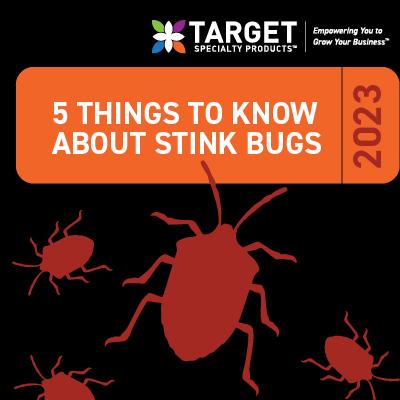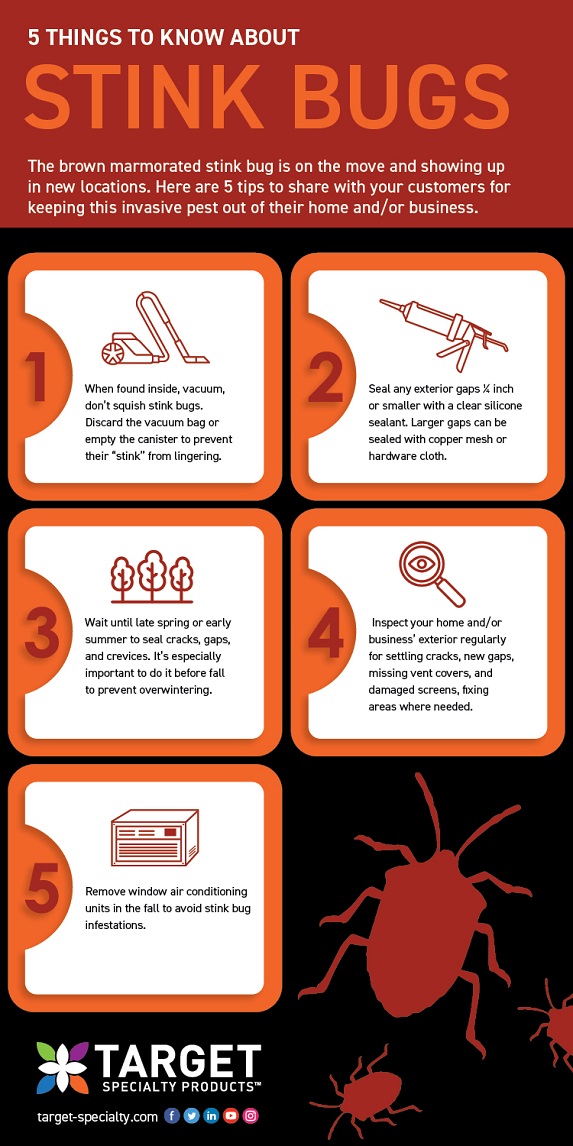
Occasional invaders, invasive pests, nuisance pests… These terms describe a number of insects; however, the one that deserves a little more attention this season is the brown marmorated stink bug (BMSB, Halyomorpha halys, from the insect family Pentatomidae). This invasive insect has the ability to squeeze its flattened, shield-shaped body into the tightest of spaces, where it can then be transported cross-country and specifically into urban areas. Recently, the brown marmorated stink bug has been discovered to have spread into new areas where it previously didn’t inhabit.
Why is this important for pest control providers to take note? Because as stink bugs begin crawling out of their overwintering sites this spring, you’re likely to receive calls from concerned customers who are not familiar with this insect. And, by keeping up with pest trends, you can proactively apply treatments and provide exclusion services, before the brown marmorated stink bug has the chance to overwinter in the fall.
Building trust with your customers
Use the information below to educate your customers about brown marmorated stink bugs. Remind them how partnering with a pest control provider can help prevent these pests and others from entering their home and/or business, now and in the future.
Stink bug behaviors
Known for being more of a structural nuisance pest, the brown marmorated stink bug will not bite people or damage buildings. It will, however, invade buildings in large numbers. When disturbed, they emit a defensive odor which can cause respiratory problems for some people who are sensitive to their allergens.
Brown marmorated stink bugs naturally seek harborage indoors, usually just before winter. The timing of their overwintering is dependent on when temperatures drop significantly, triggering a hibernation behavior. Their move to indoor spaces may occur later in the year if weather stays warmer than average.
Come fall, stink bugs seeking heat will congregate on south- and west-facing walls or surfaces that are exposed to sunlight for prolonged periods and will remain on these sun-warmed exteriors until temperatures drop.
Once temperatures cool, indicating the start of winter, stink bugs naturally move upwards, as they would in their native environment. Here they seek shelter in small interior cracks and crevices. Focus exclusion efforts on higher entry points first – areas around windows, doors, utility pipes, vents, under and around siding, etc. – then work your way down.
TIP: On warm, sunny days in early spring, be sure to have staff available and ready for an increase in calls, as overwintering stink bugs emerge from winter hibernation.
Best time to treat for stink bugs
There are a few times during the year when stink bug prevention efforts really pay off.
- Late spring/early summer: Schedule an exclusion service (sealing exterior entry points) to prevent brown marmorated stink bugs and other pests from overwintering in the fall. If a customer had stink bug activity in their home or business over winter, wait until late spring before doing exclusion to prevent sealing the insects inside.
- Fall: Follow up with your customers by performing an exterior check to help identify new entry points and potential hot spots. This is also a good time to apply treatment.
All about brown marmorated stink bugs
Discovered in Pennsylvania in 1998, the brown marmorated stink bug made its way to the U.S. from Eastern Asia where it has since expanded to forty-two other states and two Canadian provinces. This invasive species is hardy, reproduces quickly, and has few, if any, natural predators, which has aided in its ability to rapidly spread.
| Life cycle | Habitat | Behavior | Appearance | Other facts |
|---|---|---|---|---|
| Adults lay eggs on the underside of leaves. Within four to five days, nymphs will hatch. | In the fall, they seek shelter in homes and buildings to overwinter, returning to vegetation in the spring. | Congregate on screens, and around windows and doors. When crushed, they release a strong odor. | Adults are ½ inch long, mottled brown, shield-shaped body, dark and light bands on antennae, and red eyes. | Can become an agricultural pest, feeding on leaves and fruit. At this time, they’re primarily considered a nuisance. |
Stink bug hot spots
- Behind shutters
- Attics
- Around windows/screens
- Around door frames
- Along eaves
- Behind and around exterior lights
- Under fascias/soffits
- South- and west-facing walls/surfaces
- Cracks and crevices
- Gaps around utility lines/venting
- Ceiling fixtures
- Baseboards
Advise customers against DIY treatments
Self-treatments can be ineffective, costly, and in some cases do more harm than good. They might work short-term, but they can only address insects present at the time of treatment. Insects that are in hiding may not be affected. Consequently, the problem will persist. Explain to your customer that insecticide applications indoors will not prevent stink bugs from entering. Additionally, an excess of dead stink bugs can attract secondary pests.
5 things to know about stink bugs: customer tips
- Vacuum up stink bugs instead of squishing them. Empty vacuum to prevent unpleasant smell from lingering.
- Seal gaps ¼ inch or smaller with clear silicone sealant. Larger gaps can be sealed with copper mesh or hardware cloth.
- Apply caulking around newly installed utility/cable lines to eliminate gaps.
- Inspect exterior of building regularly for settling cracks, new gaps, missing vent covers, and damaged screens, fixing areas where needed.
- Remove window air conditioning units in the fall to avoid stink bug infestations.

Post-treatment reminders
Remind your customers that mechanical exclusion by sealing entry points should be done in the spring or summer to prevent entry of brown marmorated stink bugs and other overwintering pests in the fall. However, if stink bugs do make their way into their home, they are likely to see them during the winter on warm, sunny days. Stink bugs may also prematurely emerge as a result of central heating warming the exterior walls.
Stink bug prevention and more
Other nuisance pests that overwinter in indoor spaces, such as Asian lady beetles, boxelder bugs, and kudzu bugs, follow the same pattern as brown marmorated stink bugs – moving from their natural environments in the fall, then returning once spring has arrived.
Therefore, the prevention efforts used for controlling stink bugs can also be beneficial for controlling other nuisance pests – a good point to make, especially when customers are wanting to get the most out of their pest control investment.
For the treatment of brown marmorated stink bugs and other common pests, browse our complete line of insecticides or contact our sales representatives for more information.

